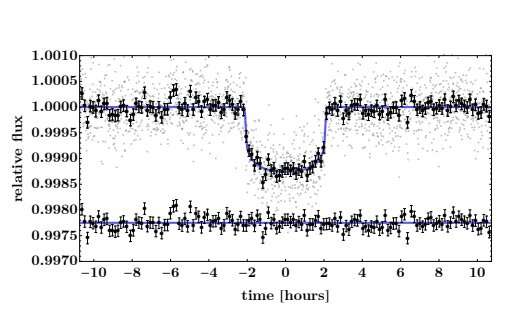New warm-Neptune exoplanet discovered

By analyzing archival radial velocity data, astronomers have detected a new warm-Neptune alien world. The newfound exoplanet, designated HD 183579b (or TOI-1055b) is about three and a half times larger and almost 20 times more massive than the Earth. The finding is detailed in a paper published January 28 on the arXiv. pre-print repository.
Although thousands of new exoplanets have been found using the transit method, this technique has one major weakness—a planet-like transit can be caused by numerous false positives. Therefore, astronomers also perform radial velocity (RV) measurements in order to confirm the planetary nature of a transit signal.
With that in mind, a team of researchers led by Skyler Palatnick of the University of Pennsylvania in Philadelphia, has analyzed archival RV surveys over the last two decades of the northern and southern skies. They have now confirmed one of the candidate exoplanets. It is an object first spotted by NASA’s Transiting Exoplanet Survey Satellite (TESS), which received designation TOI-1055b (TESS Objects of Interest).
“One exhibits an RV signature that has the correct period and phase matching the transiting planetary candidates with a false-alarm probability of less than 1%. After further checks, we exploit this fact to validate HD 183579b (TOI-1055b),” the astronomers wrote in the paper.
HD 183579b turns out to have a radius of about 3.55 Earth radii and is approximately 19.7 times more massive than our planet. It orbits its host every 17.47 days at a distance of around 0.13 AU from it. The planet’s temperature was estimated to be 769 K. All in all, the parameters of HD 183579b allowed the researchers to classify it as a so-called “warm Neptune.”
The parent star HD 183579 is a bright solar analog star of spectral type G2V. It is only about three percent more massive than the sun and has a radius of approximately 0.985 solar radii. The star is about 2.6 billion years old, has an effective temperature of 5,788 K and a metallicity at a level of some -0.023. The planetary system is located about 186 light years away in the Telescopium constellation.
Given its small size and excellent observability, HD 183579b is among the most accessible small transiting planets for future atmospheric characterization. This could be done by space observatories like the James Webb Space Telescope (JWST).
According to the astronomers, their study shows how important could be the investigation of archival datasets for confirming planetary status of some objects.
“Our work highlights that the efforts to confirm and even precisely measure the masses of new transiting planet candidates need not always depend on acquiring new observations—that in some instances these tasks can be completed with existing data,” the authors of the paper concluded.



 Creators of mankind
Creators of mankind Description of “Tall white aliens”
Description of “Tall white aliens” Where they came from?
Where they came from? About hostile civilizations
About hostile civilizations The war for the Earth
The war for the Earth “Tall white aliens” about eternal life
“Tall white aliens” about eternal life Video: “Nordic aliens”
Video: “Nordic aliens” Aliens
Aliens Alien encounters
Alien encounters The aliens base
The aliens base UFO
UFO Technology UFO
Technology UFO Underground civilization
Underground civilization Ancient alien artifacts
Ancient alien artifacts Military and UFO
Military and UFO Mysteries and hypotheses
Mysteries and hypotheses Scientific facts
Scientific facts


















